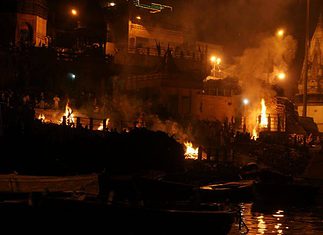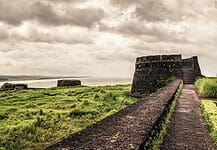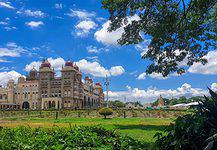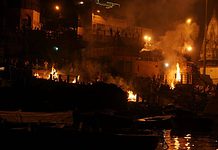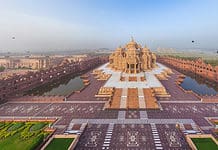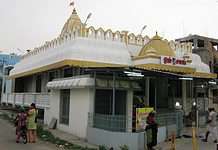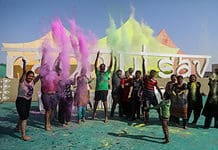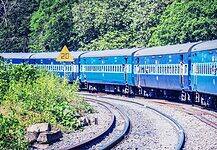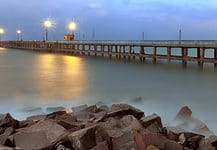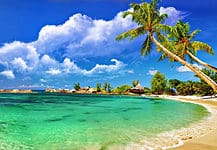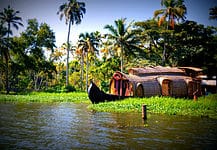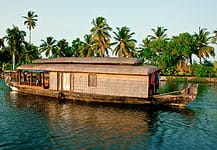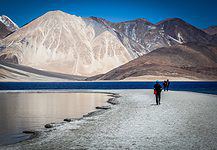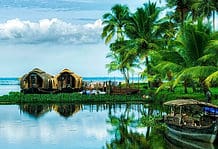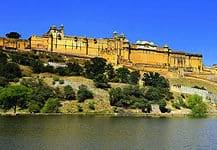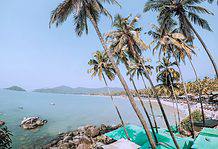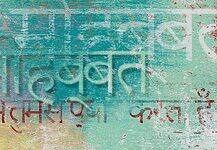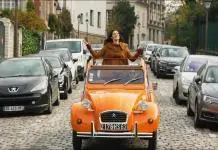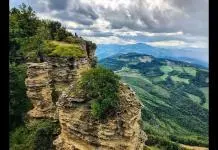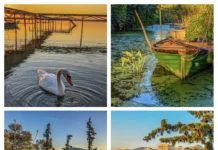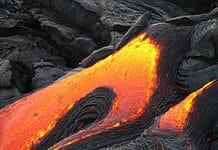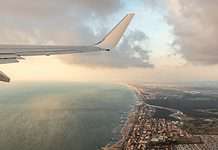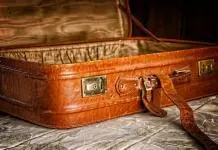Html code here! Replace this with any non empty text and that's it.
Travel to India
India, the seventh largest country in the world and surpassed only by China, in regards to the highest population, occupies a central position in South Asia.
With a history that dates as far back as the Indus Valley Civilization (third millennium BCE) and a varied geography, India is a melting pot of diverse cultures, religions, languages and ethnicities.
To provide an idea of how geographically diverse India is, there lies the great Himalayan range to the north, the Plains through which the rivers Ganga and Yamuna steer their course, the endless miles of the arid Thar Desert set in the heart of Rajasthan, the beaches and backwaters of Kerala and the relatively lesser known, pristine, lush landscapes of North Eastern India, with its Tea Gardens and alpine terrain.
Tourists come to India to visit the marble tomb of the Taj Mahal, one of the seven wonders of the world, the royal palaces and forts of Rajasthan, to scale the Himalayan peaks or visit one of India’s many beautiful northern hill stations. Other points of interest include the lush backwaters of Kerala, the Goan beaches, the Buddhist pilgrimage spot of Bodh Gaya and so much more.
It’s almost impossible to get properly acquainted with India on a single trip to the country. The opportunities to immerse oneself in the vast wealth of regional cultural opportunities, have many visitors coming back, again and again for more.
Visa for India
All foreign nationals are required to have a valid national passport along with a valid Indian Visa obtained from an Indian Mission or Post abroad. The Indian Government has greatly facilitated the visa application process by enabling the e-visa facility for nationals of at least 150 different countries. The length of time that tourists can stay in India on the e-visa has been extended from 30 to 60 days from 1 April, 2017, with a double entry permitted for tourists and business e-visas. To find further information about the visa process please visit the Indian High Commission Website.
Important Cultural Information
Indian people, as a general rule, are friendly and curious and will go out of their way to help someone. However, be wary of tourist traps and money-making schemes of overly helpful locals.
Hindi is the national language but due to the many regional languages used in different parts of India, it may not be widely spoken in some parts of the country, especially South India. English is widely spoken, especially in the big cities.
When greeting an Indian Hindu, it is customary to bring the palms together, in front of the chest and say ‘Namaskar’ or ‘Namaste’. Likewise an Indian Muslim will greet you with ‘As salaamu alaykum’.
Displays of affection, especially to persons of the opposite sex are not the norm, especially outside the big cities. Kissing in public can result in fines and even arrest.
Many Indians dress conservatively. Sleeveless shirts, short skirts and shorts may result in unwanted attention. The metropolitan cities are more liberal and people do not adhere to these strictures.
Remember to remove shoes when visiting temples, mosques and other places of worship in India.
You will also find many festivals in India, celebrating a variety of events.
Culture in India
Banking & Money
The currency in India is the Indian rupee (INR), where 100 paise make a rupee. 100,000 rupees make one lakh and 100 lakhs make 1 crore.
You can convert foreign exchange at airports or foreign exchange conversion units at banks and hotels. Cash can also be dispensed at ATM’s although there is a limit to the amount dispensed at each transaction (10,000 – 20,000 rupees).
The most common Indian Banks are State Bank of India (SBI), Allahabad Bank and other regional banks. Citibank, HSBC, RBS, Deutsche Bank and Standard Chartered are common International Banks with a number of ATMs scattered about major cities.
Credit Cards and Debit Cards are widely accepted in malls, cinemas, large restaurants and supermarkets, although cash is the popular choice in local markets and when using public transport.
Medical Emergency Information
Here is a list of emergency numbers to keep at hand in case of any emergency, medical or otherwise, in India.
100 – Police
101- Fire Engine
102- Ambulance
108- Emergency helpline
1091- Women helpline (available all over India)
1363- Incredible India Tourism helpline (Ministry of Tourism 24×7 helpline)
If you’re looking for travel insurance, we are an affiliate of World Nomads.
[/vc_column_text]
Wi-Fi and Internet in India
Mobile phones are widely used in India with the main service providers being Reliance Jio, Bharti Airtel, Vodafone, BSNL, Reliance Mobile and many more. 4G networks are available in most large cities. All cell phone numbers start with a 9 or 8. With the inclusion of the area code (varies from city to city), the length of landline numbers are 10 digits. To call internationally, prefix the number with the country code- e.g. 00 1 for the US.
To obtain a SIM card you must provide identification (xerox of passport and visa) and a passport photo along with a small fee. Wi-Fi hotspots around the city are limited, although paid Internet cafes may be used for browsing the Internet. Make sure to use a VPN while traveling and accessing Wi-Fi hotspots.
Arrival in India
Arrival at the destination will be through the major airport, closest to the tourism spot of choice. Delhi, Mumbai, Chennai, Bangalore, Kolkata – all have major international airports. To visit the Golden Triangle, Rajasthan or certain parts of the Himalayas, arriving at Delhi Airport is the best option. To visit the south of India, depending on where you want to visit, Bangalore and Chennai are both major flight hubs.
Check Expedia for available flights to India.
Areas of India
With regards to areas that tourists can visit in India, the choices are varied and far-flung.
The North of India
The North widely refers to the Himalayan mountains that occur to the north of the country. The consist of many beautiful hill-stations, some of which were popular summer destinations during the British Raj. Interspersed are many holy places of worship and interesting cities, like Varanasi (visit the burning ghats in Varanasi).
The South of India
The South has many beaches and coastal areas of natural beauty. In addition there are hill stations like Ooty, the famous backwaters of Kerala, and vibrant or historic cities like Bangalore, Chennai, Pondicherry, Hyderabad and Mysore. The South also has many ornate, ancient temples with the most stunning architecture. Further south, you can find the Andaman and Nicobar Islands and Lakshadweep.
The East and North-East of India
The East of India has large cultural cities like Kolkata and temple cities like Konark and Bhubaneswar. The North-East’s relatively untouched, lush forests have unique flora and fauna, green landscapes and areas of natural beauty.
The West of India
The West is best known for the booming Bollywood city of Mumbai, the popular beach culture of Goa, and the unending miles of the arid Thar Desert. The ornate palaces and historic forts of Rajasthan make for an unsurpassed romantic escape into the past.
Transportation in India
Within India itself, domestic flights are abundant and so traveling within the country is a breeze. Train travel is a slower option, with a chance to witness the changing terrain and landscapes, but given the size of the country, this often takes a long time. Most of the major airports are connected to the heart of the cities they service, either by metro railway, buses or taxis.
Here’s how to understand the Indian railway.
Pre-paid taxis and nowadays Uber and Ola services, are also great options for getting about in and around the city. Use 12Go to search for available trains and buses to travel across India.
Train Travel in India
Transportation In & Out of India
Indira Gandhi International Airport (DEL) is New Delhi’s airport situated about 16 km outside of New Delhi city centre. The airport is well serviced by the Metro, Buses, Taxis and Trains to New Delhi and the suburbs. Chhatrapati Shivaji International Airport (BOM) in Mumbai is the major airport serving the Mumbai area. It is connected to Mumbai via rail and metro, although taxis seem to be a convenient option.
Netaji Subhash Chandra Bose International Airport (CCU) is Kolkata’s airport located at Dum Dum. This airport is about 17 km away from the heart of the city and is serviced by pre-paid taxis, Uber/Ola and buses. Chennai International Airport (MAA) is located at Meenambakkam, about 21 km from the centre of Chennai.
The airport metro and railway services connect the airport to the city. Other major international airports are Rajiv Gandhi International Airport in Hyderabad (HYD) and Kempegowda International Airport, Bangalore (BLR) among others.
Accommodation in India
Accommodation options in India are varied and will suit all budgets. Options range from the luxury chains like the Oberoi, ITC and Taj groups. Most of these brands operate hotels in the major cities and all the lush destinations in Rajasthan.
Mid-range, quality hotels like Ginger and Country Inns are good options as well. Cheap rooms in travellers’ hotels can cost as little as 500 rupees a night in a big city. Irrespective of whether you are staying at a Maharaja’s palace, like the one in Udaipur, or an unbranded hotel, the options are innumerable, so choose wisely.
Food Dining Guide for India
The food in India varies tremendously, heavily dependent on the regional produce available locally.
The North of India and Hyderabad has many Mughlai dishes (do try biryani) – cuisine from the royal kitchens of the Mughal emperors. Northern India is also wheat growing land so many kinds of unleavened breads like roti, paratha, naan and puri are eaten along with lentils, vegetables and sometimes chicken. Spicy yoghurt dips (raita) and pickles are popular condiments to be consumed on the side.
The East of India is dominated by fish and rice along with vegetables. Mustard oil and mustard seed paste is often used for tempering, providing a sharp, peppery flavour to dishes. Sondesh and Rasgulla are some typical Bengali milk-based sweets to try.
The palate of the South of India is quite different although equally delicious. Dishes are mainly rice based. Idlis, dosa, uttapam, sambhar and rasam are all dishes to try.
In the West, Gujarati cuisine has strong vegetarian influence with ‘dhokla’ and ‘muthia’ being popular snack items. Some unique Rajasthani food items are dal baati churma and gatte ki sabzi.
India’s Attractions
One of the biggest attractions for tourists visiting India for the first time is undoubtedly, the lure of the Golden Triangle- Agra, Delhi and Jaipur. The white marble mausoleum of the Taj Mahal in Agra, with its intricate inlaid stone work of precious and semi precious stones, arches and minarets is one of the wonders of the world.
The capital of New Delhi, boasts of an ancient history which reached its pinnacle of architectural accomplishment in the days of the Mughal Emperors. The Red Fort, Humayun’s Tomb, Qutub Minar and Jama Masjid are some of the city’s highlights. The old forts and palaces of Jaipur will transport you into the rich cultural history of the Maharajas of Rajasthan. Do visit Amber Fort and the City Palace among others.
Many sun-loving tourists head to the beautiful beaches of Goa, with its lovely coastline skirting the Arabian Sea (don’t be scared to visit Goa in monsoon season – some say it’s the best time to visit!).
Ride on a houseboat in the lush backwaters of Alleppey in Kerala– also renowned for its Ayurveda Spas. Besides exploring the backwaters of Kerala, there are many other things to do in Alleppey, including visiting the historical places in Kerala.
The innumerable hill stations in the Himalayas, the National Parks of India, the Andaman and Nicobar Islands and the stark landscape of Jammu and Kashmir’s Leh Ladakh are just some other highlights.
Shopping in India
You can expect to be allured by a variety of handcrafted, artisanal items when you shop in India. Definitely bargain with prices in the street markets but shopping malls and government emporiums offer fixed prices. Handloom Indian silks and cottons are exquisite works of art.
Fabric for clothing, curtains, upholstery, bedcovers, pillowcases and tablecloths are wonderful items to shop. Wood carvings and marble and stone crafted items, often with inlaid stones make beautiful gifts to take home.
Upscale designer brands like Ritu Kumar offer the most desirable items of clothing, scarves and accessories. Forest Essentials is a luxurious company specializing in Ayurveda based skin and pampering products.
Nightlife
Nightlife in around the cities varies considerably. Goa and Mumbai definitely top the charts for the most vibrant nightlife. Mumbai is also considered a very safe city for night revellers.
Delhi has a number of cool discos and bars- some of them concentrated in and around Connaught Place.
Bangalore has a cool pub culture going on and brewpubs are also popular in Pune.
Hyderabad and Chandigarh are other cities where you can expect a good night out. Kolkata has a number of bars and pubs centred around Park Street.
Safety Tips for India
As a rule India is a safe country for visitors. However, as with most countries its best to follow a few guidelines. Avoid accepting food and drink when using public transport, especially trains. Beware of pickpockets especially in congested areas. Negotiate prices for rickshaws, tuk-tuks and other public transport in advance.
Conclusion
India is a wonderful mixture of the old and new and is one country that packs in a wealth of diverse locations to explore. India has something for every kind of explorer.
The vibrant buzz of the metropolitan cities with their emerging corporate culture, nightlife, malls and restaurants is in stark contrast with the underdeveloped rural areas.
First time visitors to India will definitely feel overwhelmed with the crowds, the congestion and the chaos of the cities. However, peaceful places can also be sought in the hill stations and wildlife sanctuaries of the land.
India is a land of contrasts and there is always something different to see, even if you have visited the country a multitude of times.

